Ecological Environment Dynamic Monitoring and Driving Force Analysis of Karst World Heritage Sites Based on Remote-Sensing: A Case Study of Shibing Karst
Abstract
:1. Introduction
2. Materials and Methods
2.1. Study Area
2.2. Data Source and Pre-Processing
2.3. Methodology
2.3.1. Ecological Indicators Extracted
2.3.2. Exploratory Spatial Data Analysis
2.3.3. Geographical Detector
2.3.4. Processing Flow
3. Results
3.1. Characteristics of the Ecological Environment
3.2. Analysis of Spatial and Temporal Variation in RSEI
3.3. Characteristics of Ecological and Environmental Quality Changes
3.3.1. Spatial Characterization Based on Global Moran’s I Index
3.3.2. Spatial Characterization Based on Local Moran’s I Index
3.4. Detection and Analysis of Factors Influencing Ecological Environment Quality
3.4.1. Single-Factor Analysis
3.4.2. Risk Detection
4. Discussion
5. Conclusions
Author Contributions
Funding
Institutional Review Board Statement
Informed Consent Statement
Data Availability Statement
Conflicts of Interest
References
- Wu, B.H.; Li, M.M.; Huang, G.P. A study on relationship of conservation and tourism demand of World Heritage Sites in China. Geogr. Res. 2002, 21, 617–626. [Google Scholar]
- Sun, K.Q. Heritage Conservation and Development; Tourism Education Press: Beijin, China, 2008. [Google Scholar]
- Jaafar, M.; Noor, S.M.; Rasoolimanesh, S.M. Perception of young local residents toward sustainable conservation programmes: A case study of the Lenggong World Cultural Heritage Site. Tour. Manag. 2015, 48, 154–163. [Google Scholar] [CrossRef]
- Lollino, G.; Giordan, D.; Marunteanu, C.; Christaras, B.; Yoshinori, I.; Margottini, C. Engineering geology for society and territory. In Volume 8 The Monviso Ophiolite Geopark, a Symbol of the Alpine Chain and Geological Heritage in Piemonte, Italy; Springer: Cham, Switzerland, 2015; Volume 40, pp. 239–243. [Google Scholar]
- Chen, X.Q.; Chen, J.G.; Cui, P.; You, Y.; Hu, K.H.; Yang, Z.J.; Zhang, W.F.; Li, X.P.; Wu, Y. Assessment of prospective hazards resulting from the 2017 earthquake at the world heritage site Jiuzhaigou Valley, Sichuan, China. J. Mt. Sci. 2018, 15, 779–792. [Google Scholar] [CrossRef]
- Pavlova, I. Global overview of the geological hazard exposure and disaster risk awareness at world heritage sites. J. Cult. Herit. 2017, 28, 151–157. [Google Scholar] [CrossRef]
- Li, G.C.; Xiong, K.N.; Xiao, S.Z. Comparison study of World Heritage geomorphologic value of Dolomite Karst in Shibing and Huanjiang. Acta Sci. Nat. Univ. Sunyatseni 2014, 53, 142–148. [Google Scholar]
- Yuan, D.X. Challenges and opportunities for karst research of our country under the new situation. Carsologica Sin. 2009, 28, 329–331. [Google Scholar]
- Xiong, K.N.; Xiao, S.Z.; Liu, Z.Q.; Chen, P.D. Comparative analysis on World Natural Heritage value of South China Karst. Strateg. Study CAE 2008, 10, 17–28. [Google Scholar]
- Xiong, K.N.; Chi, Y.K. The problems in Southern China Karst ecosystem in Southern of China and its countermeasures. Ecol. Econ. 2015, 31, 23–30. [Google Scholar]
- Titchen, S.M. On the construction of ‘outstanding universal value’: Some comments on the implementation of the 1972 UNESCO World Heritage Convention. Conserv. Manag. Archaeol. Sites 1996, 1, 235–242. [Google Scholar] [CrossRef]
- Alexander, M. Survey, surveillance, monitoring and recording. Manag. Plan. Nat. Conserv. A Theor. Basis Pract. Guide 2008, 1, 49–62. [Google Scholar]
- Bruner, A.G. Effectiveness of parks in protecting tropical biodiversity. Science 2001, 291, 125–128. [Google Scholar] [CrossRef] [PubMed] [Green Version]
- Irfan, Z.B.; Venkatachalam, L.; Jayakumar, S. Ecological health assessment of the Ousteri wetland in India through synthesizing remote sensing and inventory data. Lakes Reserv. Res. Manag. 2020, 25, 84–92. [Google Scholar] [CrossRef]
- Das, S. Assessment of wetland ecosystem health using the pressure–state–response (PSR) model: A case study of mursidabad district of West Bengal (India). Sustainability 2020, 12, 5923. [Google Scholar] [CrossRef]
- Cui, N. Impact of urbanization on ecosystem health: A case study in Zhuhai, China. Int. J. Environ. Res. Public Health 2019, 16, 4717. [Google Scholar] [CrossRef] [Green Version]
- Wu, N. An Assessment framework for grassland ecosystem health with consideration of natural succession: A case study in Bayinxile, China. Sustainability 2019, 11, 1096. [Google Scholar] [CrossRef] [Green Version]
- Smith, A.M. Remote sensing the vulnerability of vegetation in natural terrestrial ecosystems. Remote Sens. Environ. 2014, 154, 322–337. [Google Scholar] [CrossRef]
- Groom, G. Remote sensing in landscape ecology: Experiences and perspectives in a European context. Landsc. Ecol. 2006, 21, 391–408. [Google Scholar] [CrossRef]
- Hu, X.S.; Xu, H.Q. A new remote sensing index for assessing the spatial heterogeneity in urban ecological quality: A case from Fuzhou City, China. Ecol. Indic. 2018, 89, 11–21. [Google Scholar] [CrossRef]
- Ren, W.; Zhang, X.S.; Shi, Y.B. Evaluation of ecological environment effect of villages land use and cover change: A Case study of some Villages in Yudian Town, Guangshui city, Hubei Province. Land 2021, 10, 251. [Google Scholar] [CrossRef]
- Yu, Z.Y.; Deng, X.Z. Assessment of land degradation in the North China Plain driven by food security goals. Ecol. Eng. 2022, 183, 106766. [Google Scholar] [CrossRef]
- Li, Z.H. Tradeoffs between agricultural production and ecosystem services: A case study in Zhangye, Northwest China. Sci. Total Environ. 2020, 707, 136032. [Google Scholar] [CrossRef] [PubMed]
- He, D.W. Ecological efficiency of grass-based livestock husbandry under the background of rural revitalization: An empirical study of Agro-Pastoral Ecotone. Front. Environ. Sci. 2022, 10, 100. [Google Scholar] [CrossRef]
- Li, Z.H. Multilevel modelling of impacts of human and natural factors on ecosystem services change in an oasis, Northwest China. Resources. Conserv. Recycl. 2021, 169, 105474. [Google Scholar] [CrossRef]
- Wang, W.X. Impacts of infrastructure construction on ecosystem services in new-type urbanization area of North China Plain. Resources. Conserv. Recycl. 2022, 185, 106376. [Google Scholar] [CrossRef]
- Xu, H.Q. A remote sensing index for assessment of regional ecological changes. China Environ. Sci. 2013, 33, 889–897. [Google Scholar]
- Liu, Q. Ecological environment assessment in World Natural Heritage site based on Remote-Sensing Data. A case study from the Bayinbuluke. Sustainability 2019, 11, 6385. [Google Scholar] [CrossRef] [Green Version]
- Balducci, F.; Ferrara, A. Using urban environmental policy data to understand the domains of smartness: An analysis of spatial autocorrelation for all the Italian chief towns. Ecol. Indic. 2018, 89, 386–396. [Google Scholar] [CrossRef]
- Rouse, J.W.; Haas, R.H.; Schell, J.A.; Deering, D.W. Monitoring vegetation systems in the great plains with ERTS. In Proceedings of the 3rd ERTS Symposium, Washington, DC, USA, 10–14 December 1974; Volume 12, pp. 309–317. [Google Scholar]
- Freden, S.C.; Mercanti, E.P.; Becker, M.A. Third Earth Resources Technology Satellite-1 Symposium-Volume I: Technical Presentations; NASA SP-351; NASA: Washinton, DC, USA, 1974; p. 351.
- Wang, H.S. Discussion on feedback effect of soil desiccation by vegetation and related issues. Prog. Geogr. 2007, 26, 33–39. [Google Scholar]
- Huang, C.Q. Derivation of a tasselled cap transformation based on Landsat 7 at-satellite reflectance. Int. J. Remote Sens. 2002, 23, 1741–1748. [Google Scholar] [CrossRef]
- Tobler, W.R. A computer movie simulating urban growth in the Detroit region. Econ. Geogr. 1970, 46, 234–240. [Google Scholar] [CrossRef]
- Jiang, T.Y. Study on spatial and temporal evolution and factors of regional innovation in China. Econ. Geogr. 2013, 33, 22–29. [Google Scholar]
- Wang, J.F.; Xu, C.D. Geodetector: Principle and prospective. Acta Geogr. Sin. 2017, 72, 116–134. [Google Scholar]
- Li, H.L.; Yu, L. Chinese Eco-city indicator construction. Urban Stud. 2011, 18, 81–86. [Google Scholar]
- Peng, T.; Chen, X.H.; Wang, G.X.; Li, Y.H.; Li, J. Assessment of coastal wetland ecosystem health based on set pair analysis and triangular fuzzy numbers. Ecol. Environ. Sci. 2014, 23, 917–922. [Google Scholar]
- Xu, P.W.; Zhao, D. Ecological environmental quality assessment of Hangzhou urban area based on RS and GIS. Chin. J. Appl. Ecol. 2006, 17, 1034–1038. [Google Scholar]
- Wang, W.; Wang, X.L.; Feng, Z.K.; Dong, S.Y. Dynamic evaluation of eco-environmental quality in the capital economic circle based on RS and GIS. J. Anhui Agric. Univ. 2015, 42, 257–262. [Google Scholar]
- Huang, H.; Chen, W.; Zhang, Y.; Qiao, L.; Du, Y. Analysis of ecological quality in Lhasa Metropolitan Area during 1990–2017 based on remote sensing and Google Earth Engine platform. J. Geogr. Sci. 2021, 31, 265–280. [Google Scholar] [CrossRef]
- Wang, G.Q.; Guan, X.X.; Wang, L.Y.; Wang, J. Impacts of climate change and human activities on stream flow of the key runoff generation areas of the Yellow River Basin. Yellow River 2019, 41, 26–30. [Google Scholar]
- Chen, J.; Song, N.P.; Chen, L.; Wang, X.; Wang, Q.X. Soil moisture dynamics and its response to precipitation in different cover types of desert steppe. J. Soil Water Conserv. 2021, 35, 198–206. [Google Scholar]
- Fang, R.N.; Zhang, J.; Xiong, K.N. Influencing factors of residents perception of responsibilities for heritage conservation in world heritage buffer zone: A case study of libo karst. Sustainability 2021, 13, 10233. [Google Scholar] [CrossRef]
- Xiong, K.N.; Li, G.C.; Wang, L.Y. Study on the protection and sustainable development of South China Karst Libo World Natural Heritage Site. Chin. Landsc. Archit. 2012, 28, 66–71. [Google Scholar]
- Wang, Z.J.; Zhou, X.M.; Fang, Z.Q. Evaluation on the resilience of urban tourism flow network structure under the impact of COVID-19 pandemic: A case of Chongqing. J. Arid. Land Resour. Environ. 2022, 11, 148–157. [Google Scholar]
- Chen, H.S.; Feng, T.; Li, Z.C.; Fu, Z.Y.; Lian, J.J.; Wang, K.L. Characteristics of soil erosion in karst regions of Southwest China: Research Advance and Prospective. J. Soil Water Conserv. 2018, 32, 10–16. [Google Scholar]
- Li, Q.; Yang, Y.G.; Ti, B.; Xu, K.; Zhao, X.Q. Integrated aerial-space-ground ecological monitoring technology system of Baima Snow Mountain National Nature Reserve. J. West China For. Sci. 2021, 50, 49–54. [Google Scholar]
- Wu, L.X.; Li, J.; Miao, Z.L.; Wang, W.; Chen, B.Y.; Li, Z.W.; Dai, W.J.; Xu, W.B. Pattern and directions of spaceborne-airborne-ground collaborated intelligent monitoring on the geo-hazards developing environment and disastersin glacial Basin. Acta Geod. Cartogr. Sin. 2021, 50, 1109–1121. [Google Scholar]
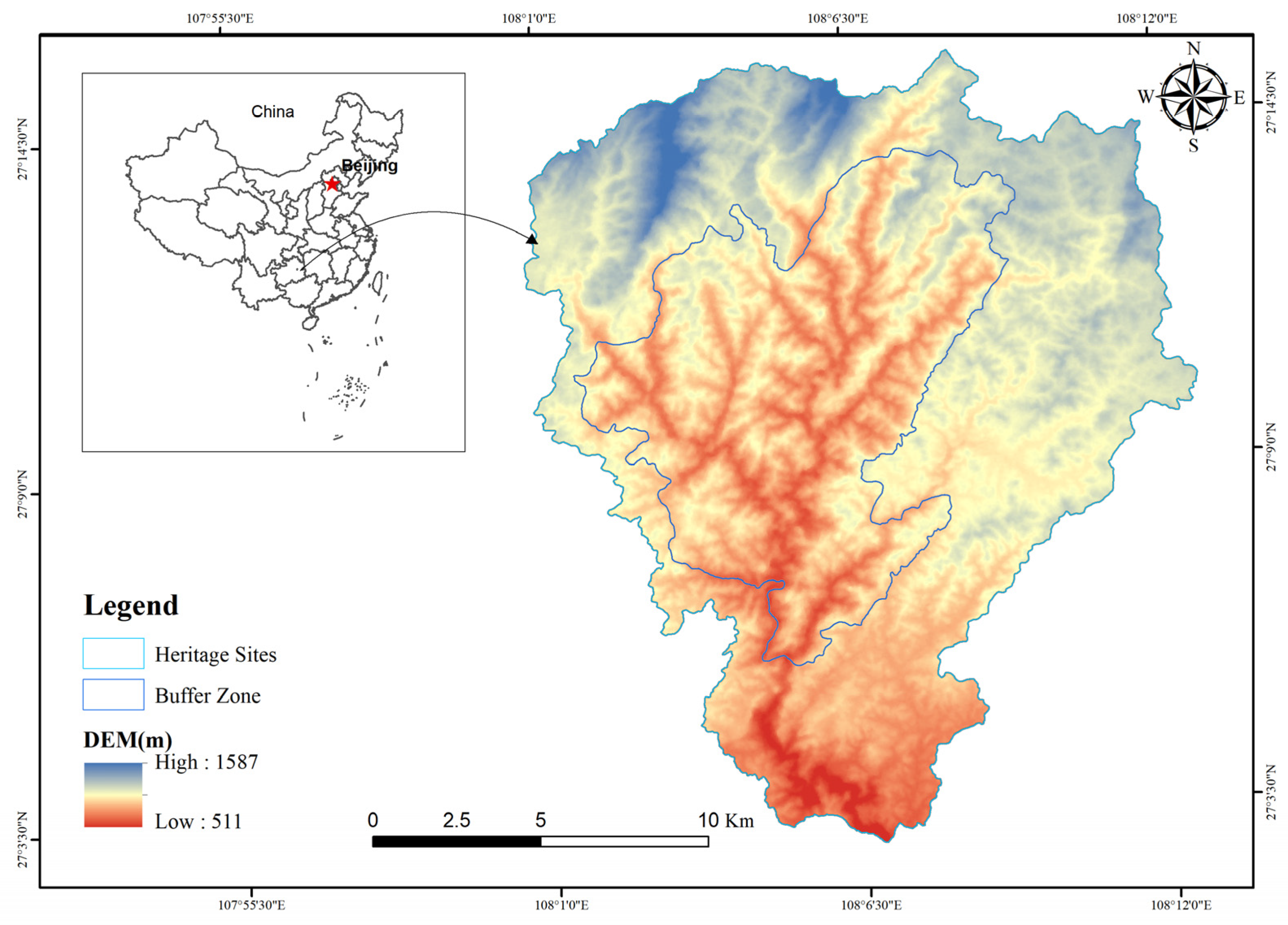
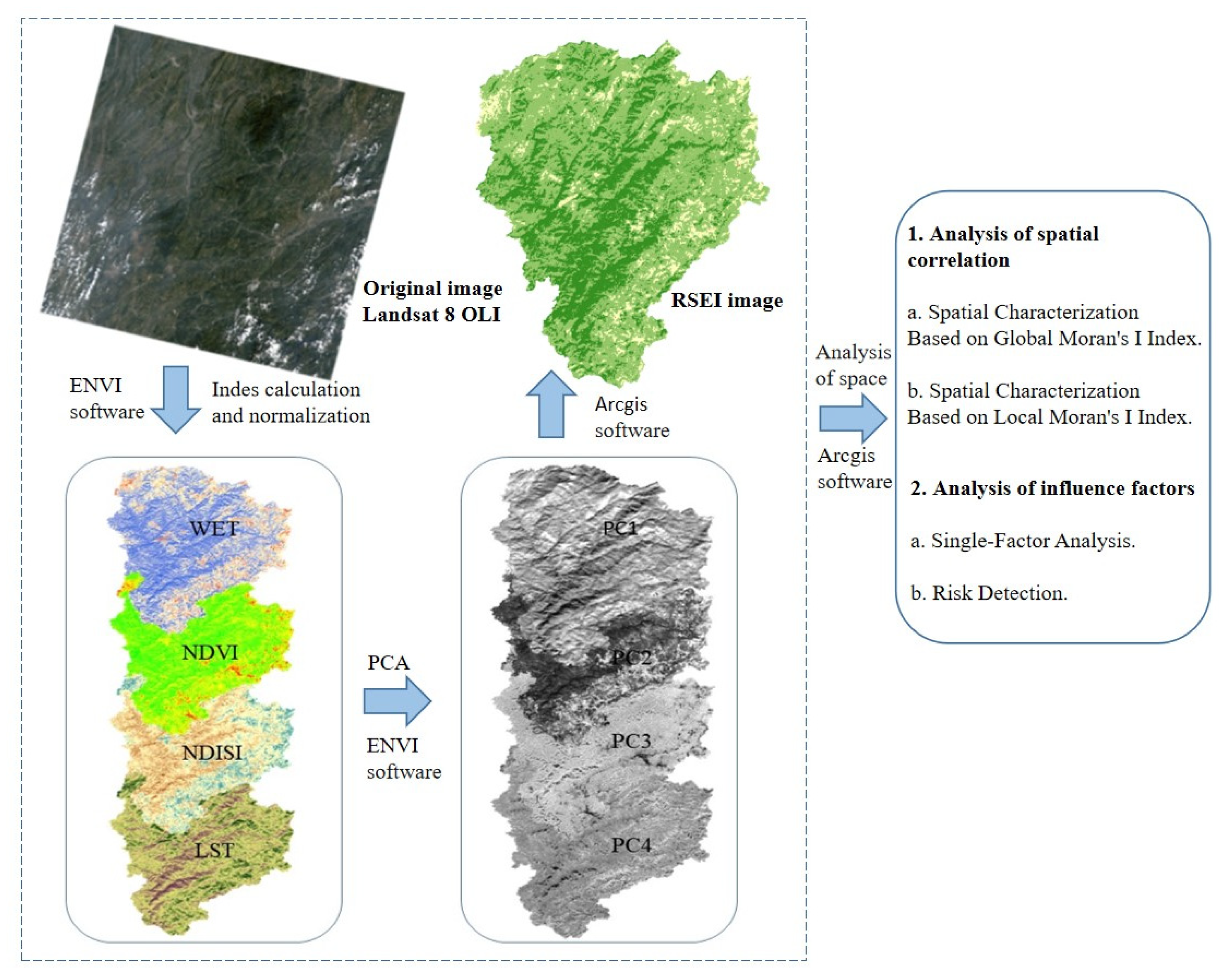
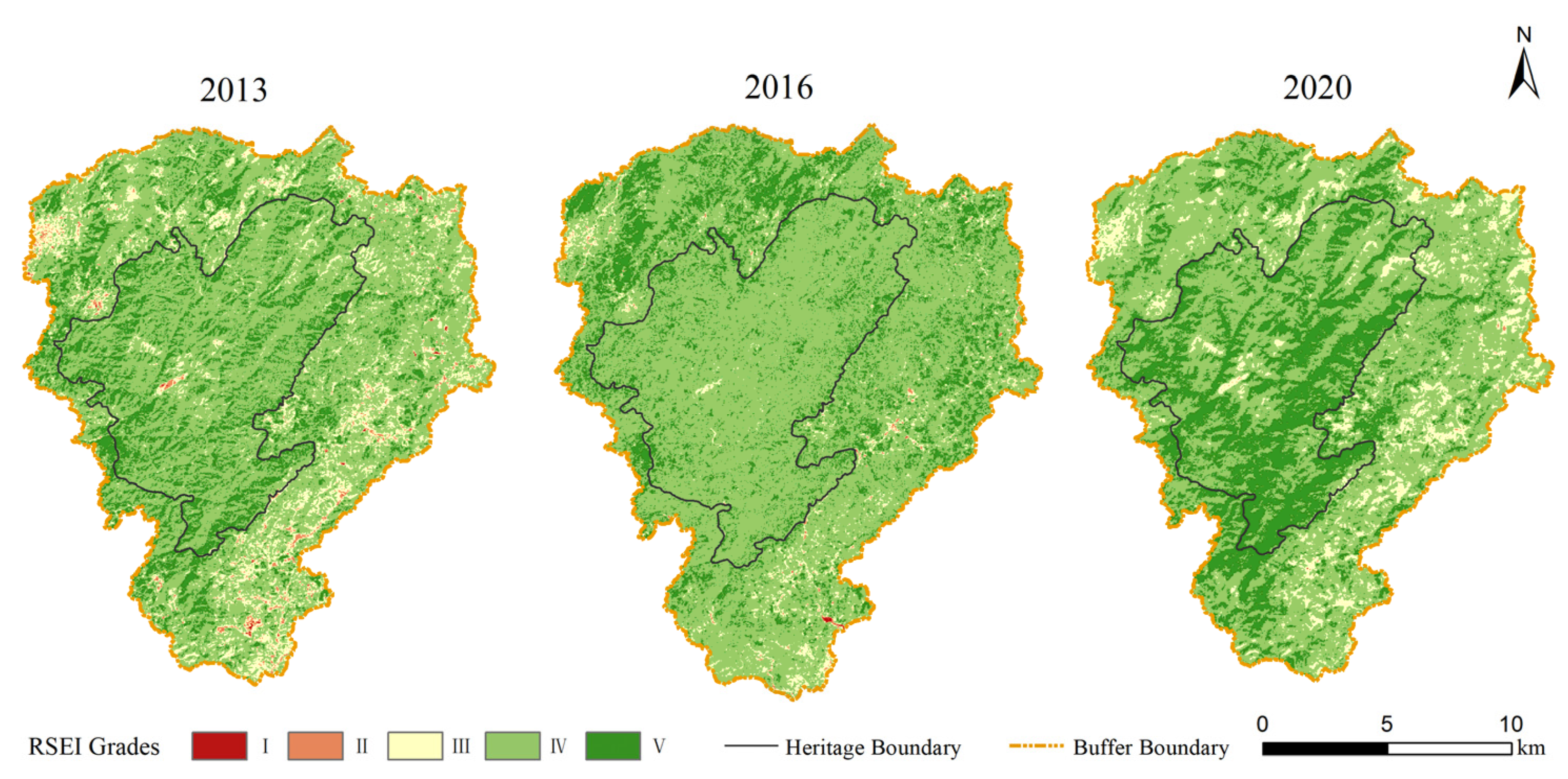
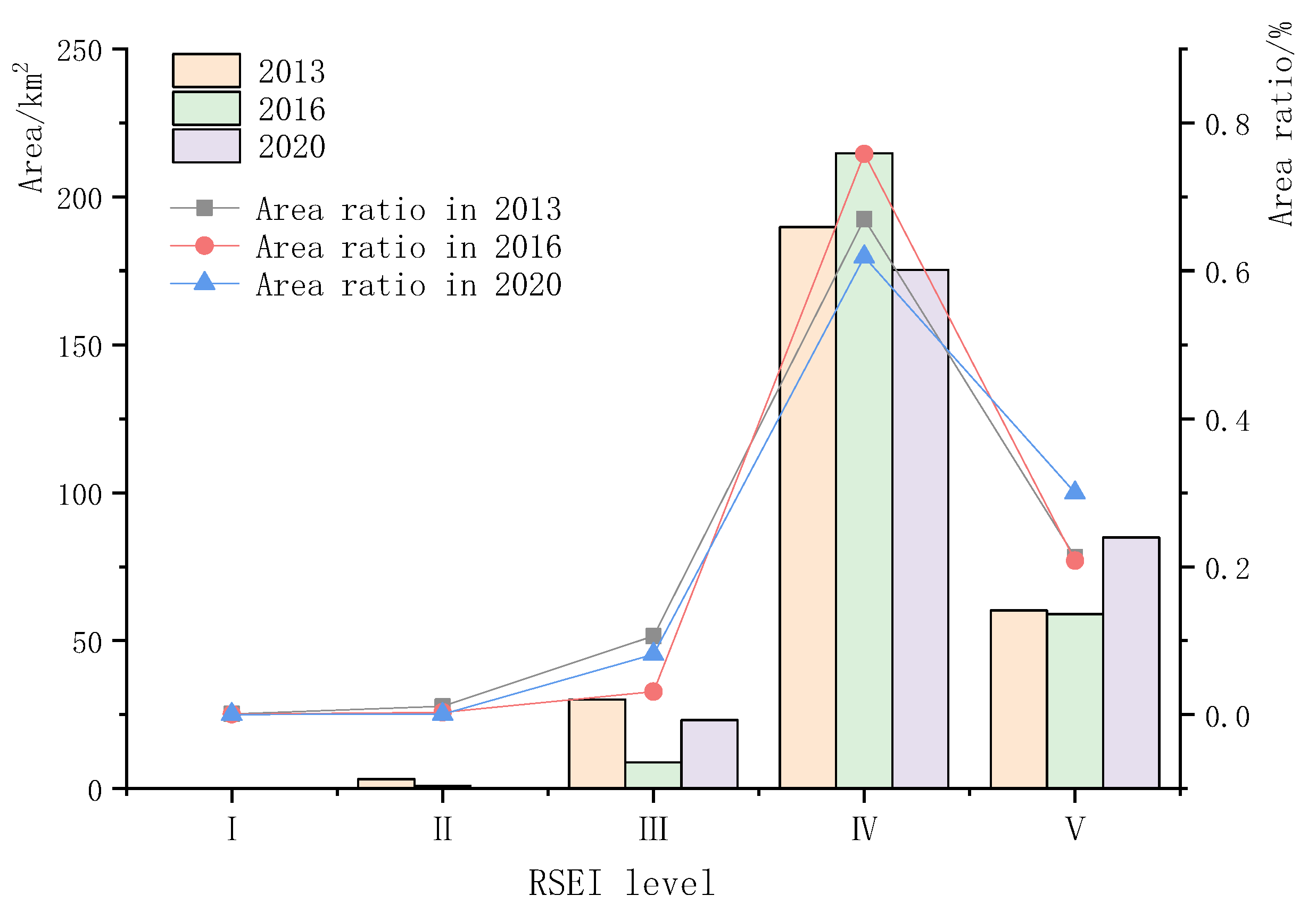


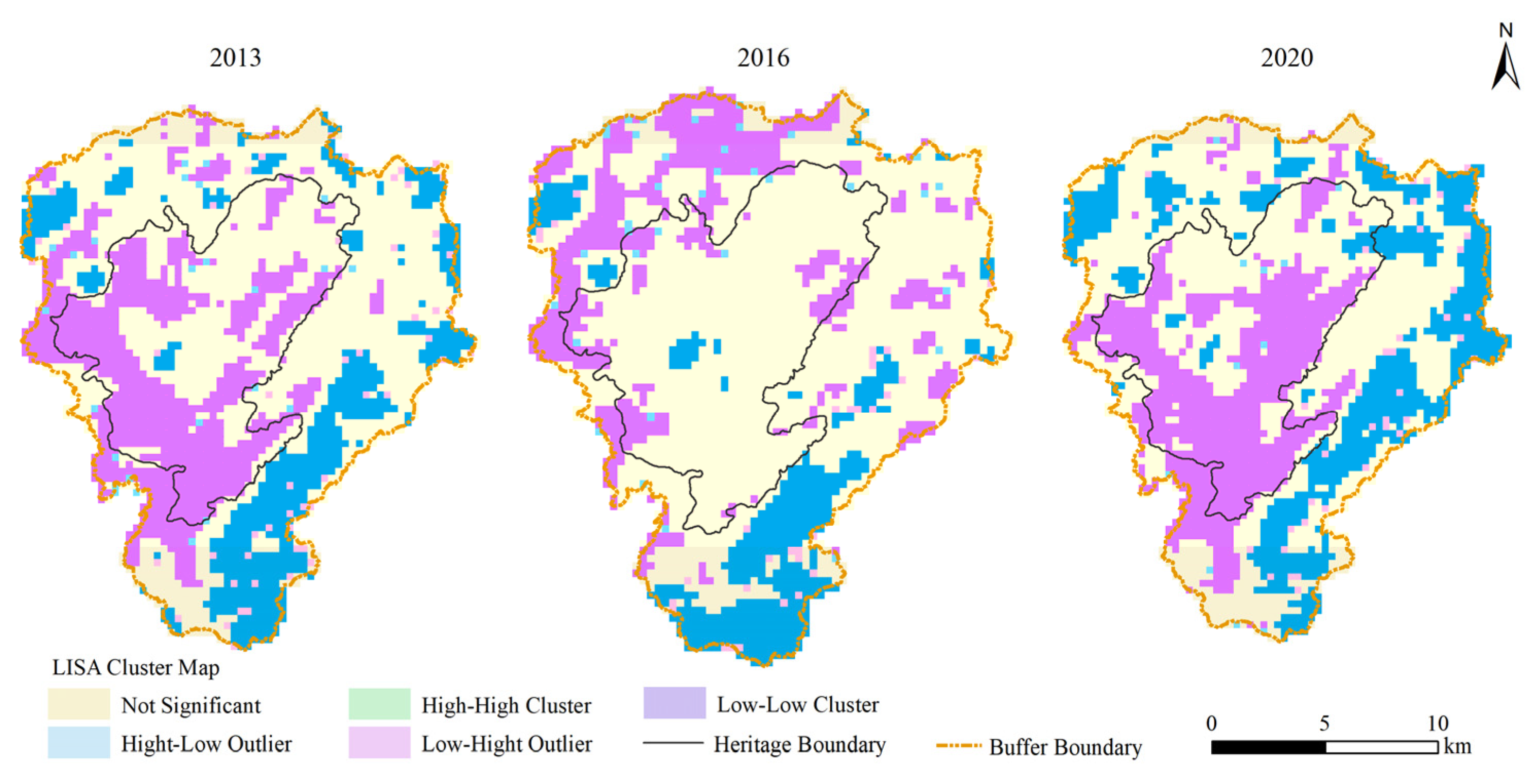
| Year | PC1 | PC2 | PC3 | PC4 | |
|---|---|---|---|---|---|
| 2013 | Eigenvalues/λ | 0.012 | 0.002 | 0.001 | 0.000 |
| Contribution Ratio/% | 80.21% | 11.51% | 7.81% | 0.47% | |
| 2016 | Eigenvalues/λ | 0.660 | 0.001 | 0.001 | 0.0001 |
| Contribution Ratio/% | 87.42% | 7.9% | 3.46% | 1.22% | |
| 2020 | Eigenvalues/λ | 0.008 | 0.002 | 0.001 | 0.000 |
| Contribution Ratio/% | 80.56% | 10.94% | 6.17% | 2.33% |
| Year | Index | RSEI | |||
|---|---|---|---|---|---|
| NDVI | WET | NDISI | LST | ||
| 2013 | 0.773 | 0.753 | 0.880 | 0.469 | 0.720 |
| 2016 | 0.782 | 0.776 | 0.509 | 0.570 | 0.723 |
| 2020 | 0.829 | 0.895 | 0.345 | 0.436 | 0.742 |
| Area (km2) | 2020 | |||||
|---|---|---|---|---|---|---|
| 2013 | I | II | III | IV | V | Total |
| I | 0 | 0.019 | 0.095 | 0.051 | 0 | 0.165 |
| II | 0 | 0.027 | 1.980 | 1.109 | 0.005 | 3.121 |
| III | 0.001 | 0.041 | 13.095 | 16.797 | 0.077 | 30.011 |
| IV | 0.001 | 0.006 | 7.869 | 144.407 | 37.489 | 189.772 |
| V | 0 | 0.002 | 0.035 | 12.895 | 47.288 | 60.220 |
| Total | 0.002 | 0.095 | 23.074 | 175.259 | 84.859 | 283.289 |
| Factors | 2013 | 2016 | 2020 |
|---|---|---|---|
| NDVI | 0.418 | 0.611 | 0.364 |
| NDISI | 0.823 | 0.900 | 0.798 |
| WET | 0.907 | 0.750 | 0.834 |
| LST | 0.279 | 0.271 | 0.531 |
| DEM | 0.011 | 0.033 | 0.129 |
| LUCC | 0.612 | 0.341 | 0.655 |
Disclaimer/Publisher’s Note: The statements, opinions and data contained in all publications are solely those of the individual author(s) and contributor(s) and not of MDPI and/or the editor(s). MDPI and/or the editor(s) disclaim responsibility for any injury to people or property resulting from any ideas, methods, instructions or products referred to in the content. |
© 2023 by the authors. Licensee MDPI, Basel, Switzerland. This article is an open access article distributed under the terms and conditions of the Creative Commons Attribution (CC BY) license (https://creativecommons.org/licenses/by/4.0/).
Share and Cite
Zhang, N.; Xiong, K.; Xiao, H.; Zhang, J.; Shen, C. Ecological Environment Dynamic Monitoring and Driving Force Analysis of Karst World Heritage Sites Based on Remote-Sensing: A Case Study of Shibing Karst. Land 2023, 12, 184. https://doi.org/10.3390/land12010184
Zhang N, Xiong K, Xiao H, Zhang J, Shen C. Ecological Environment Dynamic Monitoring and Driving Force Analysis of Karst World Heritage Sites Based on Remote-Sensing: A Case Study of Shibing Karst. Land. 2023; 12(1):184. https://doi.org/10.3390/land12010184
Chicago/Turabian StyleZhang, Ning, Kangning Xiong, Hua Xiao, Juan Zhang, and Chuhong Shen. 2023. "Ecological Environment Dynamic Monitoring and Driving Force Analysis of Karst World Heritage Sites Based on Remote-Sensing: A Case Study of Shibing Karst" Land 12, no. 1: 184. https://doi.org/10.3390/land12010184





